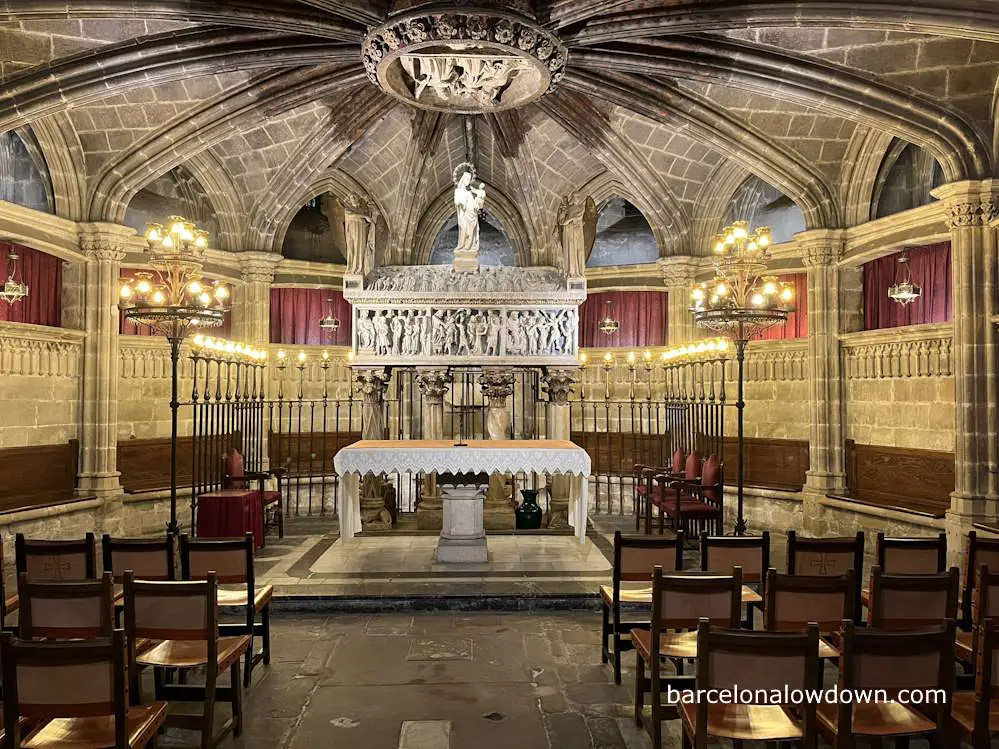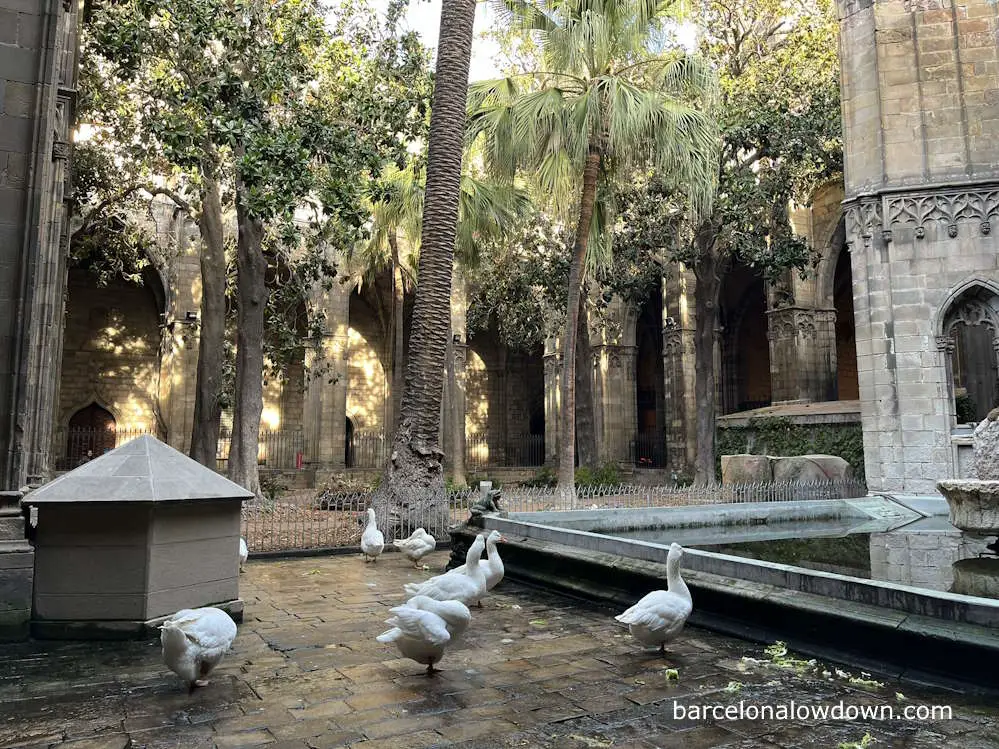Barcelona’s magnificent Gothic cathedral dates back to the thirteenth century and is one of the city’s oldest and most historic buildings.
The cathedral is famous for its ornate Neo-Gothic façade, peaceful cloister and stone gargoyles that channel water from the roof. Other highlights include the elaborately carved choir stalls and the crypt containing the remains of Santa Eulalia, one of the city’s patron saints.
Another reason for visiting Barcelona Cathedral is to go up onto the roof. The cathedral is one of the tallest buildings in the Gothic Quarter, and tickets, which can be purchased online, include access to the roof terraces, which offer spectacular 360º views of the city.
This post covers everything you need to know before visiting Barcelona Cathedral.

A Brief History of Barcelona Cathedral
Barcelona Cathedral was built over a period of 150 years during the thirteenth, fourteenth and fifteenth centuries and is dedicated to Santa Eulalia, one of the city’s patron saints.
The site where the cathedral stands has been a place of worship since the times of the Roman Empire, and there is evidence of a paleo-Christian basilica on the site since the fourth century AD.
During the fifth and sixth centuries, the original cathedral was extended before being badly damaged when Barcelona was attacked and razed to the ground by Almanzor, then ruler of the Cordoba Caliphate, in 985.
In 1046, construction began on a Romanesque-style cathedral, which was consecrated in 1058. Later, in 1298, a new Gothic cathedral was built on the remains of the earlier buildings.
The construction of the cathedral, as we see it today, was finalized in 1448. However, the ornate Neo-Gothic façade and the 70m tall central tower were not added until much later. For almost five hundred years, the main entrance to the cathedral was the Portal de Sant Iu, located on the northeast side of the building.

What to See in Barcelona Cathedral
Here are a few of the highlights when visiting Barcelona Cathedral.
Exterior Features
Before entering the Cathedral, it’s worth spending a few minutes walking around the outside of the building.
The Gothic Façade
The Cathedral’s main façade is the most impressive part of its exterior. It was designed during the fifteenth century but wasn’t built until the end of the nineteenth century.
The focal point of the façade is the Cathedral’s main entrance, flanked by stone statues of the apostles and adorned with intricate carvings. The entire façade is highly ornate, in contrast to the rest of the building’s exterior, which is relatively austere, as is typical of the Catalan Gothic style.

Portal de Sant Iu
If you walk clockwise around the cathedral, you will soon come to the Portal de Sant Iu, which was the cathedral’s original entrance. The doorway is built of marble and stone from Montjuïc and features carvings of knights fighting dragons and other mythical beasts. One of the figures is said to represent Wilfred the Hairy, who is often credited with being the founder of Catalonia.
Gargoyles
As you continue around the outside of the cathedral, you should look upwards and be on the lookout for Gargoyles.
Apparently, there are more than a hundred and fifty gargoyles adorning the walls of Barcelona Cathedral, carved into the forms of mythical and real creatures. The best-known gargoyles are the unicorn and the bull, both of which can be seen from Carrer de la Paietat.
Another interesting feature to look out for is the solitary carved shoe, indicating that the shoemaker’s guild was involved in the cathedral’s construction.

Interior Highlights
After admiring the cathedral’s imposing exterior, it’s time to see what’s inside.
The Choir
Directly in front of you, as you enter the cathedral, stand the impressive gothic choir stalls where the monks used to stand during services. The choir dates back to the latter part of the fourteenth century and is considered to be one of the best examples of Catalan Gothic sculpture. The coats of arms painted above each of the seats belonged to the Knights of the Order of the Golden Fleece and were added during the sixteenth century.
The Nave and Chapels
The nave of the cathedral is flanked by twenty-six side chapels, each dedicated to a saint and decorated in different styles, primarily Gothic, though some are Renaissance and Baroque. Above the chapels there are stained glass windows which illuminate the cathedral’s interior.
The Crypt
Beneath the altar, there’s a raised crypt that houses a sarcophagus with the remains of Santa Eulalia, who is the Patron of the cathedral and co-patron of Barcelona. Eulalia was the daughter of a wealthy Christian family who was martyred by the Romans when she was thirteen years old.

The Roof Terraces
To the left of the main altar, there’s a lift which takes you up to the cathedral’s rooftops. Here, in addition to a close-up view of the cathedral’s towers, you also get excellent 360º panoramic views of Barcelona.
The Cloisters
One of the most popular features of Barcelona Cathedral is the cloisters, which were built during the fifteenth century.
In one corner of the cloisters stands a fountain with a small statue of Sant Jordi. Each summer, during Corpus Christie, the fountain is adorned with flowers in a quirky Barcelona tradition called l’Ou Com Balla.
The cloisters are also home to thirteen white geese, one for each year of Santa Eulalia’s life.
The Chapter House
On one side of the cloisters is a chapter house where the bishop used to hold meetings. Currently, the chapter house serves as a small museum where some of the cathedral’s religious treasures are displayed.
Note: This is the only part of the cathedral where you’re not allowed to take photos.

Practical Visitor Information
Time Needed to Visit
You should allow approximately ninety minutes to visit Barcelona Cathedral. This gives you enough time to fully appreciate the grandeur of the Cathedral’s nave and chapels, spend some time in the cloisters, and check out the views from the roof terrace.
Information in English
The audio guide is available in English, and there are free leaflets near the entrance to the Cathedral, available in several languages, including English.
Location and how to get there
Barcelona Cathedral is located in the Gothic Quarter, a five-minute walk from Plaça de Catalunya.
Address: Pla de la Seu, s/n, Barcelona
The nearest metro station is Jaume I on Line 4, the yellow line.
Tickets
| Ticket | Price |
| General | €14 |
| Under 12 years | €6 |
| Under 3 years | FREE |

Audioguide & Tours
Entry to the Cathedral includes an audioguide, which you download to your phone by scanning a QR code just after entering the Cathedral.
My free self-guided walking tour of Barcelona’s Gothic Quarter visits Barcelona Cathedral.
Visiting times
| Day | Visiting Times |
| Monday to Friday | 9:30 to 18:30 (last entry 17:45) |
| Saturdays and eves of religious holidays | 9:30 to 17:15 (last entry 16:40) |
| Sundays and religious holidays | 14:00 to 17:00 (last entry 16:30) |
Catholic Mass
| Day | Times |
| Monday to Friday | 9:00, 11:00, 12:00, 19:15 |
| Saturdays and eve of religious holidays | 9:00, 11:00, 12:00, 18:00, 19:15 |
| Sundays and religious holidays | 9:00, 10:30, 12:00, 13:00, 18:00, 19:15 |
Note: Although you are allowed to visit the Cathedral when mass is taking place, you won’t be able to access the altar and the crypt at this time. More information on the Cathedral’s website.
Other Attractions Nearby
- The Gothic Quarter
- The Kiss Mural
- The Bishop’s Bridge
- Paça de Sant Felip Neri
- Barcelona History Museum
Map
Pla de la Seu, s/n, Barcelona
FAQs and Tips
This section contains answers to some of the most frequently asked questions about Barcelona Cathedral. If you’ve any further queries, please feel free to leave them in the comments section below. I’ll do my best to get back to you as soon as possible.
Is Barcelona Cathedral worth visiting?
Barcelona Cathedral is a magnificent Gothic cathedral that dates back to the thirteenth century and is well worth visiting. Highlights include the impressive central nave, with more than twenty side chapels, the peaceful cloisters and the panoramic views from the roof terraces.
How long does it take to visit Barcelona Cathedral?
You should allow approximately ninety minutes to visit Barcelona Cathedral. This allows you enough time to fully explore the cathedral’s interior and spend some time on the roof enjoying the views of Barcelona’s Gothic Quarter.
Can you visit Barcelona Cathedral for free?
Although it is possible to visit the Cathedral free of charge for religious purposes, you are only allowed access to a very small part of the building.

Do you need to purchase tickets for Barcelona Cathedral in advance?
Tickets for Barcelona Cathedral do not usually sell out. However, you can save time and avoid the queues by purchasing tickets online.
What’s the best time to visit Barcelona Cathedral?
The best time to visit Barcelona Cathedral is at 9:30 in the morning, shortly after it opens, or in the afternoon, from about four p.m. onwards, since the building is less crowded at this time.
The best time for taking photos of the Gothic façade is in the afternoon since the Cathedral faces west, although if you want to take photos without people, like the ones in this post, you should visit early in the morning.
Is Barcelona Cathedral accessible to wheelchair users?
Yes, people in wheelchairs can access the cathedral via the cloisters, through the door on Carrer del Bisbe.
What’s the Dress Code at Barcelona Cathedral?
You should dress conservatively and ensure that your shoulders, back, and midriff are covered. If you wear a skirt or shorts, they should cover below mid-thigh. Plunging necklines and transparent clothes are not allowed. If you wear a hat or cap, you should remove it before entering the cathedral.
Unlike the Sagrada Familia, where you will often see people wearing shorts or singlets, the dress code is strictly enforced in Barcelona Cathedral. You may be turned away if you are unsuitably dressed, and your ticket will not be refunded.

Is Barcelona Cathedral the same as the Sagrada Familia?
Barcelona Cathedral is a large Gothic cathedral located in the city’s Gothic Quarter. The cathedral dates back to the thirteenth century and should not be confused with the Sagrada Familia, a basilica designed by Antoni Gaudí and still under construction.
What’s the full name of Barcelona Cathedral?
Barcelona Cathedral is called the Cathedral of the Holy Cross and Saint Eulalia, or La Catedral de la Santa Creu i Santa Eulàlia in Catalan.
Are you allowed to take photos inside Barcelona Cathedral?
Photography is permitted inside Barcelona Cathedral, with the exception of the chapter house.




